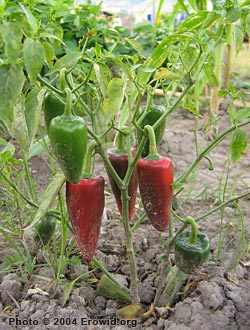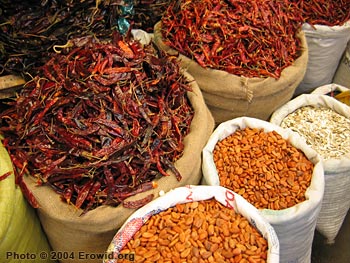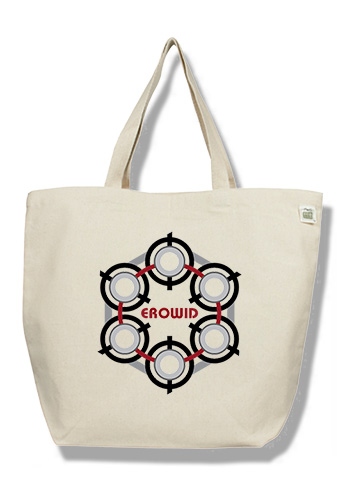Hot Chiles
Surfing the Burn
Nov 2004
Citation: Erowid E, Erowid F. "Hot Chiles: Surfing the Burn." Erowid Extracts. Nov 2004;7:16-17.
From crimson reds and magma browns to lively yellows, bright purples, and unripe greens, chiles of
various colors, shapes, and sizes are abundant in Mexico. Many Mexicans eat chile peppers or chile-
based sauces at every meal and many snacks include chile powder. For some people, food just
doesn’t taste right without chiles.
In Oaxaca, Mexico, dried and fresh chiles and chile powder are piled high in virtually every store
and market. Oaxacan cuisine, like many in Mexico, is permeated with the bite of the abundant chile
varieties available there. Most restaurants have chile-based sauces on each table or serve them
with meals. For those who don’t love this family of fiery fruits, it can be a little difficult
to find edible food at a restaurant.
There are more than twenty species of chiles, but almost all of the domesticated forms belong to one of five: Capsicum annuum, C. baccatum, C. chinense, C. frutescens, and C. pubescens.1 Within these five species are hundreds of varieties, all native to the Americas, many with long histories of human use. Archaeological evidence from the Tehuacán Valley in Mexico suggests that wild Capsicum species have been used for nearly 9,000 years and cultivated for more than 6,000.2
Capsicum species didn’t enter European pharmacognosy until Columbus and his crew encountered them on the island of Hispaniola (modern Greater Antilles) in 1494. Columbus’s voyages were spurred by the desire for a better route to the East Indies for the spice trade. While he didn’t find the East Indies, he did find spices.
The unfamiliar chile plant was at first misidentified as a relative of black pepper (Piper nigrum). The common term "chile pepper" comes from this mis-identification combined with the Náhuatl (Aztec) word for the plant, chilli. Diego Alvarez Chanca, a physician on Columbus’ second voyage, first documented their New World use in a letter to the town council of Seville.3 He also brought samples back to Spain and it wasn’t long before chiles spread through Europe and beyond, including Asia, where they changed the face of many national cuisines.
The pungent chemicals in chiles responsible for sensations of heat and pain are called
capsaicinoids--the primary being capsaicin, an extremely potent material detectable to the taste in
the milligram range. The capsaicinoid content of different chile peppers varies greatly, ranging by
as much as a factor of 30,000 as measured by the Scoville Scale, the most popular method of
measurement for chile "heat" (see sidebar).
When a hot chile is ingested, the capsaicinoids stimulate nerve receptors in the mouth, nose, and throat that detect heat. The stimulation of these receptors (called vanilloid receptors subtype 1 or "VR1") causes the release of the neuropeptide "substance P", which acts as a neurotransmitter for pain messages, into the bloodstream. The brain then interprets this signal as burning, although there is largely no actual chemical burn. Instead, the perceived pain is the result of a direct stimulation of the pain-sensing neuromechanism, the effects of which are an intense burning sensation in the mouth, teary eyes, runny nose, sweating, and increased blood flow to the exposed areas.
Chiles have been used in war to take advantage of this physiological response. The Maya burned chiles upwind from their enemies in battle and threw chile extract to blind them (and of course modern pepper spray is made using capsaicin). Chiles were also used by the Maya to punish disobedient children. The sixteenth century Mendocino Codex shows a father punishing his son by forcing him to inhale the smoke from roasting chiles. The modern Poplocán Indians near Oaxaca reportedly still use this method of punishment.4
Capsaicin-based medicines are also now being used to treat pain associated with arthritis, cystitis, human immunodeficiency virus, and diabetic neuropathy. Peppers with high capsaicin content are not only important as foods, medicines, inspirations for weapons and macho chile-eating games, they are also a commonly available and widely used short-acting psychoactive.
The body releases endorphins in response to substance P. Endorphins are a class of endogenous neurotransmitter that are produced as natural painkillers; they bind to opioid receptors in the brain, acting as a strong analgesic and psychoactive alterant. While smaller doses of chiles result primarily in an uncomfortably hot mouth, they can hint at the more powerful effects lurking within the full experience; a subtle clarity of mind or unexpected giddiness may follow.
While lower intensity effects are better suited for chronic, daily use, many who enjoy chile peppers find themselves compelled to add capsaicin to their food, becoming increasingly tolerated to its effects and finding meals without them boring or unsatisfying. It is the reaction to higher doses that most people reference when discussing chile’s mental effects. Perhaps the Jesuit priest Jose de Acosta was aware of this when he warned in 1590 that the chile was "prejudicial to the health of young folks, chiefly the soul, for it provokes to lust".4
The pain and endorphin release triggered by eating chiles can cause a slowly building but powerful
rush with a duration similar to that of smoked DMT (5–20 minutes). The impact on the mental
state of the hot chile eater is undisputable, causing a short-lived but intense altered state that
can include increased heart rate, physical and mental stimulation, detachment and dissociation,
increased or decreased ability to concentrate, and euphoria. The combination of these effects puts
chiles squarely into the pantheon of psychoactive plants.
Experienced users share stories and techniques for how to achieve the desired results. One common technique, called "mouth-surfing" by Andrew Weil, is designed to maximize the psychoactive experience. By continuing to eat small quantities of chiles at a constant rate, the user can maintain a "steady burn" that leads to a continuous, long-term endorphin release. According to Weil, this technique "brings about a high state of consciousness".5
Users also share recommendations for favorite chile varieties. One might be hotter, but another might have longer-lasting effects. New products are regularly marketed to chile lovers, from endless varieties of salsas and chile sauces--with names like "Endorphin Rush" and "Molten Lava"--to capsaicin nasal spray (!), which is touted for its medicinal uses but also used by athletes and endorphin addicts for its mental effects.6
Looking at chiles through the Erowid lens, it is interesting and more than a little amusing that in chile-loving parts of the world such as Mexico, nearly every house and every restaurant comes equipped with a bowlful of psychoactive sauce. Easily grown and readily available, chiles are a household staple as well as a powerful psychoactive, putting burning, sweaty, dissociative, altered states within arm’s reach at any moment.

|
There are more than twenty species of chiles, but almost all of the domesticated forms belong to one of five: Capsicum annuum, C. baccatum, C. chinense, C. frutescens, and C. pubescens.1 Within these five species are hundreds of varieties, all native to the Americas, many with long histories of human use. Archaeological evidence from the Tehuacán Valley in Mexico suggests that wild Capsicum species have been used for nearly 9,000 years and cultivated for more than 6,000.2
Capsicum species didn’t enter European pharmacognosy until Columbus and his crew encountered them on the island of Hispaniola (modern Greater Antilles) in 1494. Columbus’s voyages were spurred by the desire for a better route to the East Indies for the spice trade. While he didn’t find the East Indies, he did find spices.
The unfamiliar chile plant was at first misidentified as a relative of black pepper (Piper nigrum). The common term "chile pepper" comes from this mis-identification combined with the Náhuatl (Aztec) word for the plant, chilli. Diego Alvarez Chanca, a physician on Columbus’ second voyage, first documented their New World use in a letter to the town council of Seville.3 He also brought samples back to Spain and it wasn’t long before chiles spread through Europe and beyond, including Asia, where they changed the face of many national cuisines.
|
The Scoville Scale#
The Scoville Scale measures the heat of chile peppers. It was invented in 1912
by Wilbur Scoville, a pharmacologist working to develop a capsaicin-based
muscle salve for the Parke Davis pharmaceutical company.The design of the original test--named the Scoville Organoleptic Test--called for a solution of chile extract to be diluted in sugar water until three out of five human tasters were no longer able to detect the heat of the chile. The ratio of sugar water to extract became the chile’s heat ranking. The more sugar water required, the hotter the chile and the higher its heat ranking. Heat rankings--recorded in "Scoville heat units"--range from 0 SHU for a sweet bell pepper to more than 855,000 SHU for the recently tested Naga Jolokia from India (this result has yet to be verified). Though Scoville’s Scale is still used, his original testing methodology has been replaced by HPLC (High Pressure Liquid Chromatography), which is able to directly measure the amount of capsaicin present in chile extract. |
When a hot chile is ingested, the capsaicinoids stimulate nerve receptors in the mouth, nose, and throat that detect heat. The stimulation of these receptors (called vanilloid receptors subtype 1 or "VR1") causes the release of the neuropeptide "substance P", which acts as a neurotransmitter for pain messages, into the bloodstream. The brain then interprets this signal as burning, although there is largely no actual chemical burn. Instead, the perceived pain is the result of a direct stimulation of the pain-sensing neuromechanism, the effects of which are an intense burning sensation in the mouth, teary eyes, runny nose, sweating, and increased blood flow to the exposed areas.
Chiles have been used in war to take advantage of this physiological response. The Maya burned chiles upwind from their enemies in battle and threw chile extract to blind them (and of course modern pepper spray is made using capsaicin). Chiles were also used by the Maya to punish disobedient children. The sixteenth century Mendocino Codex shows a father punishing his son by forcing him to inhale the smoke from roasting chiles. The modern Poplocán Indians near Oaxaca reportedly still use this method of punishment.4
Capsaicin-based medicines are also now being used to treat pain associated with arthritis, cystitis, human immunodeficiency virus, and diabetic neuropathy. Peppers with high capsaicin content are not only important as foods, medicines, inspirations for weapons and macho chile-eating games, they are also a commonly available and widely used short-acting psychoactive.
The body releases endorphins in response to substance P. Endorphins are a class of endogenous neurotransmitter that are produced as natural painkillers; they bind to opioid receptors in the brain, acting as a strong analgesic and psychoactive alterant. While smaller doses of chiles result primarily in an uncomfortably hot mouth, they can hint at the more powerful effects lurking within the full experience; a subtle clarity of mind or unexpected giddiness may follow.
While lower intensity effects are better suited for chronic, daily use, many who enjoy chile peppers find themselves compelled to add capsaicin to their food, becoming increasingly tolerated to its effects and finding meals without them boring or unsatisfying. It is the reaction to higher doses that most people reference when discussing chile’s mental effects. Perhaps the Jesuit priest Jose de Acosta was aware of this when he warned in 1590 that the chile was "prejudicial to the health of young folks, chiefly the soul, for it provokes to lust".4

|
Experienced users share stories and techniques for how to achieve the desired results. One common technique, called "mouth-surfing" by Andrew Weil, is designed to maximize the psychoactive experience. By continuing to eat small quantities of chiles at a constant rate, the user can maintain a "steady burn" that leads to a continuous, long-term endorphin release. According to Weil, this technique "brings about a high state of consciousness".5
Users also share recommendations for favorite chile varieties. One might be hotter, but another might have longer-lasting effects. New products are regularly marketed to chile lovers, from endless varieties of salsas and chile sauces--with names like "Endorphin Rush" and "Molten Lava"--to capsaicin nasal spray (!), which is touted for its medicinal uses but also used by athletes and endorphin addicts for its mental effects.6
Looking at chiles through the Erowid lens, it is interesting and more than a little amusing that in chile-loving parts of the world such as Mexico, nearly every house and every restaurant comes equipped with a bowlful of psychoactive sauce. Easily grown and readily available, chiles are a household staple as well as a powerful psychoactive, putting burning, sweaty, dissociative, altered states within arm’s reach at any moment.
References #
- Kilham C. Psyche Delicacies. Rodale, 2001.
- MacNeish RS. "First Annual report of the Tehuacán Archaeological-Botanical Project". R.S. Peabody Foundation for Archaeology, No. 1. 1961.
- Chanca DA. "Letter of Dr. Chanca on the Second Voyage of Columbus". Wisconsin Historical Society Digital Library and Archives. Accessed Oct 15, 2004. http://www.americanjourneys.org/aj-065/
- Dewitt D. The Whole Chile Pepper Book. Little, Brown and Co., 1990.
- Weil A. The Marriage of the Sun and Moon. Houghton Mifflin Co., 1980.
- "All Natural Pepper Nasal Spray Produces a Natural High." Jul 12, 2004. Accessed Oct 15, 2004. http://www.prweb.com/releases/2004/7/prweb140516.htm


